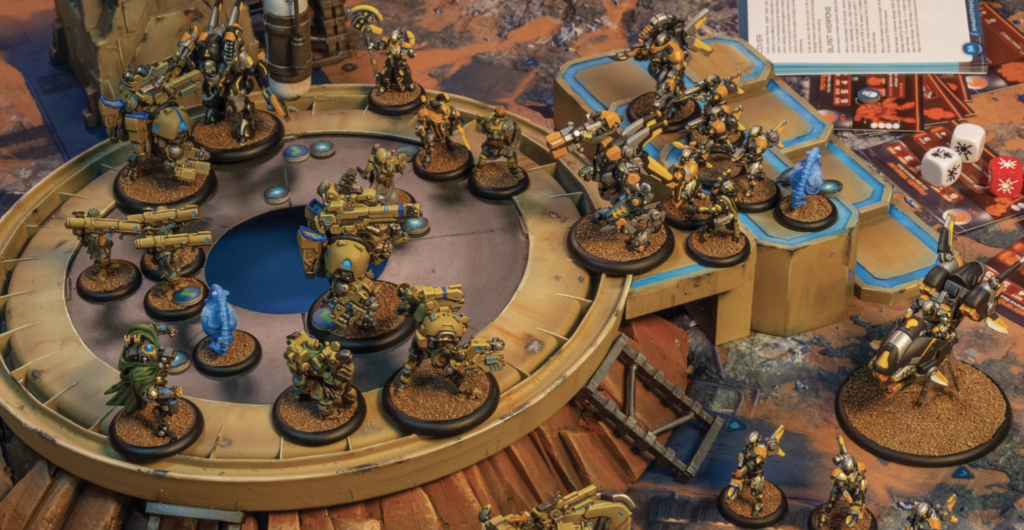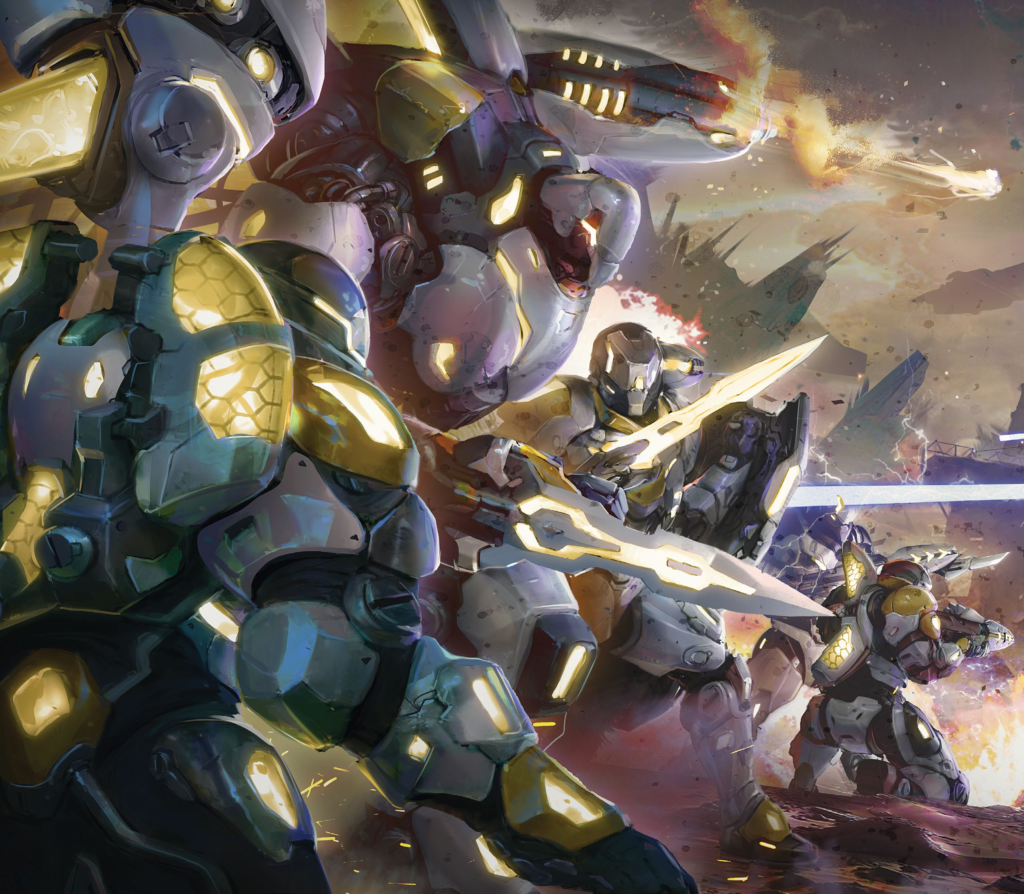A new pack of 15 scenarios, designed for both Primary and Skirmish size games, using a standard 36″ board and updated rules for stealth. This is intended to iron out inconsistencies in the Primary and Skirmish experience, and make it easier to balance the game.
By Martyr for the Cause and Paradox
Hello there! Today we’d like to introduce you to what we like to call the Standard format for Warcaster: Neo-Mechanica. We’ll talk about what Standard is, why we made it, and provide a full list of modified scenarios with maps. We hope that you will enjoy it as much as we do!
What is Standard?
Simply put, Standard is a standardized format for playing Warcaster. Instead of having two different formats, with two different sizes, we’ve consolidated and standardized both the map size and scenario list. Hence, it is “Standard.” Gone are the dichotomies of Skirmish and Primary, now you can simply enjoy a scalable game at any size on one map and one scenario set.
So why make Standard?
Basically two reasons:
- We love Warcaster.
- We wanted to take the best of both formats and make one game fully scalable and able to be internally balanced.

Reason 1: We Love Warcaster!
It really is our primary game to play now. We both jumped in early on Kickstarter 1, and have played pretty steadily since mid-late-2020. Like many folks, we started with the “Starter Boxes” plus a couple units, played Skirmishes, and built up to 8/1 games. Then took the leap into Primary scenarios, very quickly adopting the fan-based “mid” sized games of 11/2 with 4 turns per pulse, and using Primary missions on a 4×4 board. We’ve event played a few Full Battle Force games at 15/3, with 5 turns per pulse, but for time constraint reasons, we most often enjoy 11/2 and 4 turns per.
And, like many folks, over time we found that Skirmish games were dominated by warjacks – especially heavy warjacks – and given the 30” map size and ability of any unit to score, it soon felt like the balance might be a little off at that scale. So when playing Primary missions, it was quite refreshing to find that game felt MUCH more balanced. Warjacks were less impactful, and squads much more so.
However, over time, we noticed that we would take less and less warjacks in a list, and that we were deploying these less and less as well. Simply put, in most Primary scenarios, warjacks cannot score points, so those “unit activations” each turn were almost always used by squads, and occasionally by vehicles when they could score. But similarly, as Kickstarters 2 and 3 released and we grew our collections, we noticed that vehicles were also largely ignored and often not even taken, because they could not score points either.
Reason 2: One standard format.
It was touch to get other locals interested when you tried to explain the two game sizes, or to shepherd new players through a somewhat imbalanced Skirmish scale to being able to play Primary. So we struck on the idea of making a map bigger than Skirmish but smaller than primary. We also felt this could address some balance issues we saw. First, the predominance of warjacks in Skirmish vs the predominance of squads in Primary. Second helping vehicles matter more overall. Third, adjusting Stealth to be a meaningful rule (whereas in Skirmish is generally is not).
We also wanted to keep the parts we liked best of each format. The ability to play on a smaller map, have quicker games, and for things to feel balanced and scale well over all game sizes.
Smaller maps than a 4×4 are appealing. For example, many newer games use much smaller maps, and these fit easily on a countertop or kitchen table. No need for a dedicated gaming table that’s 4’ across or 6’+ long! We wanted to scale up a little from 30”x30” because we felt that contributed to the dominance of warjacks and impacted the value of Stealth. But we also wanted to move away from a full on 4×4, which is less usable in demos and intro games, and feels like a size of gaming past.

Key Changes
We also felt a consolidated list of scenarios was more desirable, allowing much greater variety in gaming experiences at all sizes.
So we landed at a 36”x36” map size, and we adjusted the existing scenarios from there, working from the Thousand Worlds Sourcebook. One thing we did when adjusting the distances of objectives was to aim for 3” measuring intervals, making maps easily intuitive and easily readable in small formats (like your phone screen). Another was to make a standard list of terms that could be applied across scenarios, making it easier to remember scoring paradigms and objective types. And in doing this, we tried to avoid making any changes at all to game or card rules, focusing just on the scenarios themselves. We did not want to make home-brewed basic game adjustments. But we DID have to make one exception – Stealth. Simply put, the 8” Stealth rules was not worth much at all on a 30” board, and even a 36” board did not really solve the issues. However, in our games playing Primary, we did find that the 8” rule felt just right on a 48” map, so we scaled the Stealth rule down to 6”, to match the ratio of the scaled-down map. We found it worked perfectly!
From there, we got to tweaking which units could score which scenarios, which scenario scored end of activation (EoA) vs end of pulse (EoP), and moving/adding/removing objectives where it felt necessary. The overall end result was a roughly even balance between EoA and EoP, and with squads and vehicles nearly always being the default scoring units. There are a few scenarios where warjacks can score, usually just 1 central objective, or where solos can score. And a couple “any unit” scenarios where we felt it worked.
We ended up at 15 scenarios! We did focus on making sure a handful were smaller-game friendly, so that if you’re playing demos or intro games, or anything smaller than 8/1, you have options that are friendly. However, we feel all scenarios are playable at any size 81/ to 15/3, and 3 turns per pules to 5 turns per pulse. Basically, the scenario pack and list do not need to change, unlike Skirmish/Primary, you need only agree on a game size and go.
Below you will find a link to the basic scenario rules and the scenario maps. These are print-friendly and you should be able to easily double side them.
We also put together a smaller format printable packet for quick reference. It’s two pages, double-sided, which we hope facilitates ease of use.
Let us know what you think! We’re always open to feedback, and if we have some good suggestions, we can do an update!
Demonstration size scenarios
For reference, the following scenarios are meant to be playable at less than 8/1 size (but are also playable at bigger sizes too):
- Absolute Pressure
- Apotheosis Agenda
- Boiling Point
- Chaos Theory
- Moonshadow
- Necropolis Dreaming
- Surface Tension
Pingback: Standard Format Update 2025 - Arcane Synthesis